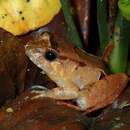en
names in breadcrumbs


Limnonectes palavanensis (common names: smooth guardian frog, Palawan wart frog) is a species of frog in the family Dicroglossidae. It is found in the Palawan Island (the Philippines, its type locality) and in Borneo (Brunei, Indonesia, Malaysia).[3][4] The species shows paternal care,[2][4] a relatively rare trait in frogs.[5]
Male Limnonectes palavanensis grow to about 30 mm (1.2 in) and females to about 40 mm (1.6 in) in snout–vent length. There is a V-shaped ridge between the shoulders, and a sharp interorbital band that separates the anterior part of the head from differently colorer back. Juveniles have a medial vertebral stripe that in some populations persists in adults too.[4]
The tadpole is moderately flat (dorsoventrally compressed). The tail is twice the length of the body. The tail fin is low and ends in a pointed tip.[4]
The male of this species guard the tadpoles that hatch from the eggs laid on the ground. The male then carries the tadpoles on its back to water.[2][4]
Its natural habitats are lower montane and lowland forests. The tadpoles develop in small rain pools[2] and quiet sections of small, slow moving streams.[4]
The habitat of this species is mostly well protected, although it can potentially be impacted by habitat loss.[2] It occurs in the Crocker Range National Park.[1]
Limnonectes palavanensis (common names: smooth guardian frog, Palawan wart frog) is a species of frog in the family Dicroglossidae. It is found in the Palawan Island (the Philippines, its type locality) and in Borneo (Brunei, Indonesia, Malaysia). The species shows paternal care, a relatively rare trait in frogs.